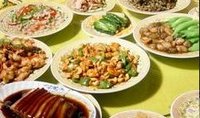
Beijing imperial food from the Ming and pre- Ming dynasties has mostly disappeared by today. What has been preserved is the Qing Dynasty imperial cuisine because its cooks passed down their knowledge and skills, and because the palace kept dietetic records.
General Feng Yuxiang (1882 - 1948) drove Puyi (1906 - 1967), the last Qing emperor, out of the Forbidden City in 1924 and disbanded the imperial garden, was opened to the public in 1925. Former cooks of the Qing imperial kitchen, Sun Shaoran, Wang Yushan, Wen Baotian, Niu Wenzhi, and Zhao Yongshou, then opened a tea – house in Beihai Park with help from Zhao Renzhai, former chief of the palace vegetable storehouse.
Their teahouse was named Fangshan, which means imitation imperial food. They specialized in making and selling the orthodox pastries of the Qing Palace. From making and selling tea, pastries, and refreshments, Fangshan gradually evolved into serving the traditional dishes of the Qing Palace. Many literati and tourists dined at the restaurant out of admiration for their imperial dishes. The restaurant soon became famous throughout the city because of its fresh raw materials, excellent cooking, and unique flavors.
Beijing imperial food from the Ming and pre- Ming dynasties has mostly disappeared by today. What has been preserved is the Qing Dynasty imperial cuisine because its cooks passed down their knowledge and skills, and because the palace kept dietetic records.
General Feng Yuxiang (1882 - 1948) drove Puyi (1906 - 1967), the last Qing emperor, out of the Forbidden City in 1924 and disbanded the imperial garden, was opened to the public in 1925. Former cooks of the Qing imperial kitchen, Sun Shaoran, Wang Yushan, Wen Baotian, Niu Wenzhi, and Zhao Yongshou, then opened a tea – house in Beihai Park with help from Zhao Renzhai, former chief of the palace vegetable storehouse. Their teahouse was named Fangshan, which means imitation imperial food. They specialized in making and selling the orthodox pastries of the Qing Palace. From making and selling tea, pastries, and refreshments, Fangshan gradually evolved into serving the traditional dishes of the Qing Palace. Many literati and tourists dined at the restaurant out of admiration for their imperial dishes. The restaurant soon became famous throughout the city because of its fresh raw materials, excellent cooking, and unique flavors.
The restaurant’s staple food was cooked wheaten products, such as baked sesame seed cakes with fried minced-meat filling and pastries shaped like apple, peach, fingered citron, and lucky rolls. Whatever wheaten food you ate, you received a good luck message: apple – all is well; peach – longevity, you will live a long life; lucky rolls – everything is fine.
Although imperial food originated with the common people, imperial food uses different raw materials. The rice, flour, meat, vegetables, melon, fruit, poultry, fish, and delicacies from land and sea were carefully chosen tributes from local officials throughout the country. They were unmatched in quality and purity.
Beijing fangshan of Cold dishes could not be combined on one plate. A plate of boiled chicken should just be boiled chicken and nothing else. A plate of jellyfish salad should be nothing but jellyfish salad, and the same for smoked fish, preserved eggs, and pork cooked in soy sauce. They should all be served on separate plates. There was nothing similar to the assorted cold dishes of today, which are modeled like a work of modern art.

No comments:
Post a Comment